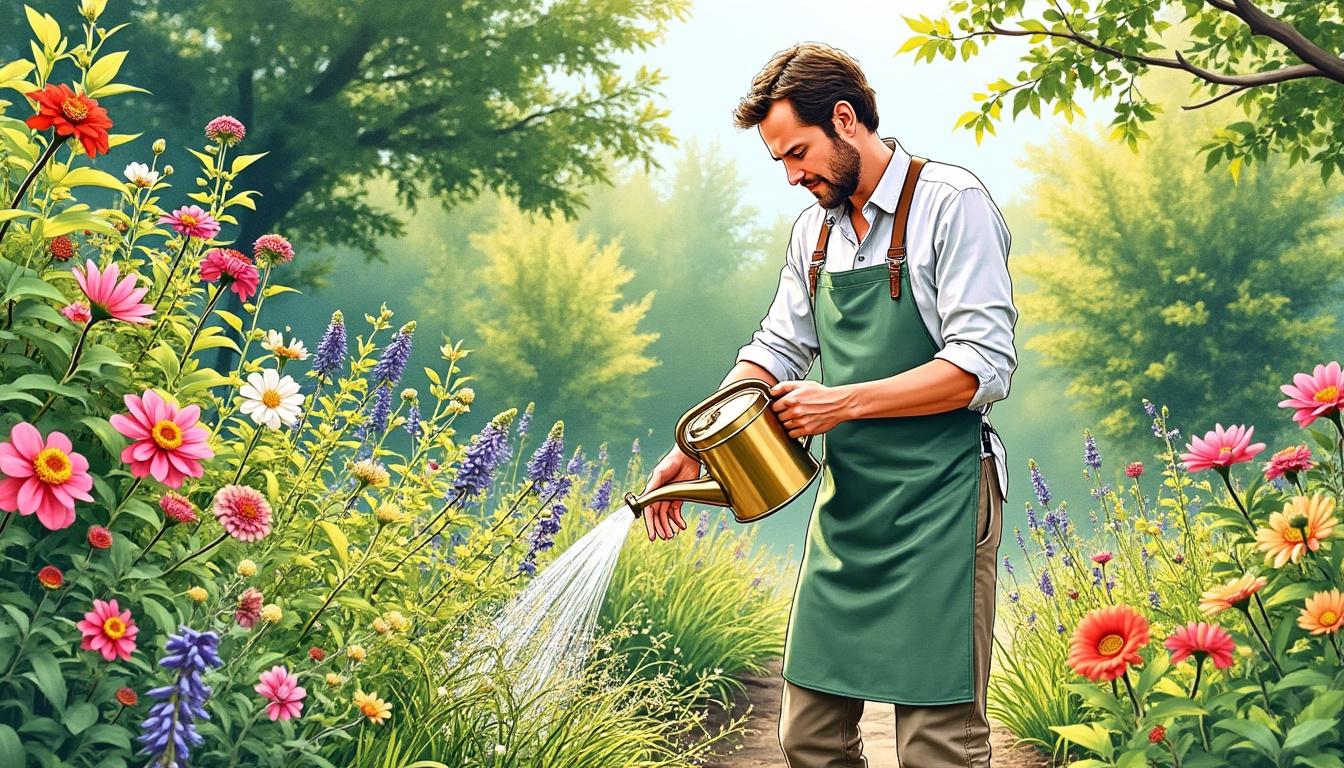The challenge of reviving parched plants resonates deeply with gardeners and plant enthusiasts alike, especially when confronted with scorching summers and unpredictable rainfall. As gardens thirst under the relentless sun, the expertise of renowned garden designer Diarmuid Gavin offers invaluable insights for nurturing revitalized, thriving greenery. His approach emphasizes understanding the intricate water needs of plants and adopting practical techniques that transcend conventional watering methods. Unlocking the secret to successfully bringing back dry, struggling plants involves more than just frequent watering; it requires a strategy grounded in horticultural science and years of experience, intersecting with innovations from trusted brands such as Miracle-Gro, Espoma, and Proven Winners. This article delves into essential strategies and expert tips inspired by Diarmuid Gavin’s advice to transform dehydrated flora into lush, vibrant spectacles once again.
Effective Watering Techniques For Reviving Thirsty Plants
Diarmuid Gavin highlights a common misconception that many gardeners encounter: simply wetting the surface of the soil does not suffice to quench a plant’s true thirst. Traditional watering methods via hose or watering can often fail to penetrate deeply, leaving roots parched beneath a damp exterior. This insight becomes crucial in revitalizing plants that appear wilted or stressed.
One of the best practices for deep hydration is to encourage water absorption by saturating the soil so moisture reaches the roots profoundly. Deep watering not only replenishes the plant’s essential water reserves but also promotes root growth deeper into the soil, increasing resilience.
Here is a list of watering techniques Diarmuid advises:
- Slow Soaking Method: Water plants slowly at the base to allow time for deep soil absorption rather than quick surface wetting.
- Use of Soaker Hoses or Drip Irrigation: These methods deliver water gradually and directly to root zones, minimizing evaporation.
- Watering Early or Late: Applying water during early mornings or late evenings reduces water loss due to heat.
- Watering Frequency Adjustment: Rather than frequent shallow watering, allow longer intervals between watering to encourage roots to search deeper for moisture.
Renowned garden suppliers like Miracle-Gro and Scotts offer soil moisture meters and irrigation accessories designed to optimize watering habits. Combining their products with expert advice can dramatically improve outcomes for thirsty plants.
| Watering Method | Benefits | Recommended Tools |
|---|---|---|
| Slow Soaking | Ensures deep soil saturation and reduces water runoff | Watering can with fine spout, soaker hose |
| Drip Irrigation | Efficient watering with minimal evaporation | Drip emitters, timers |
| Morning/Evening Watering | Limits water evaporation and stress on plants | Timer-based sprinklers, manual watering |
| Moisture Monitoring | Prevents over- or under-watering | Soil moisture meters, apps |
The Role Of Soil Quality And Amendments In Plant Revival
Water alone cannot revive wilted plants if the underlying soil conditions inhibit moisture retention or root health. According to Diarmuid Gavin, attention to soil quality is paramount when addressing thirsty plants. Healthy, well-amended soil acts like a reservoir that holds water and nutrients essential for plant recovery.
In recent years, advances from companies like Espoma and Burpee have enriched the market with organic soil amendments and fertilizers that improve soil aeration, water retention, and nutrient availability. Incorporating these can significantly accelerate a plant’s return to vigor.
Key soil improvement tactics include:
- Adding Organic Matter: Compost and well-rotted manure enrich soil structure, improving moisture holding capacity.
- Using Mulch: Mulching conserves soil moisture and regulates temperature, reducing plant stress from heat.
- Soil pH Adjustments: Ensuring the soil pH suits the specific plant species promotes nutrient absorption.
- Improving Drainage: Amending clay-heavy soils with sand or perlite avoids waterlogging, which can harm roots.
Brands like Gardenia and Greenhouse Megastore offer specialized substrates and soil conditioners crafted to meet these needs, enhancing rehydration processes effectively. Proper soil preparation complements watering efforts and forms the foundation for healthy plant life in any garden climate.
| Soil Amendment | Main Function | Best Use Case |
|---|---|---|
| Compost | Enhances nutrient content and soil microbes | General garden beds, flower borders |
| Mulch | Retention of soil moisture and temperature control | Around shrubs, perennials, vegetable gardens |
| Sand/Perlite | Improves drainage and aeration | Clay soils and heavy pots |
| pH Adjusters (Lime, Sulfur) | Optimizes nutrient availability | Soils with unsuitable pH for specific plants |
Choosing The Right Plants And Varieties To Enhance Garden Resilience
Diarmuid Gavin underscores the importance of selecting plants that naturally withstand drier periods, reducing the risk of extensive plant stress and the subsequent need for drastic rescue measures. Utilizing plants adapted to local climates or drought-tolerant varieties can profoundly cut down maintenance efforts and watering needs.
For gardeners seeking to introduce reliable, hardy species, trusted sources like Proven Winners, Bloomscape, The Sill, and Houseplant Shop provide a wide array of resilient plant options. These providers emphasize sustainable cultivation and often categorize plants by water usage and care requirements, supporting informed choice aligned with specific garden conditions.
Key drought-tolerant plants include:
- Succulents: Their fleshy leaves store water, making them ideal for dry spells.
- Lavender and Rosemary: Mediterranean herbs well suited to low-water gardens.
- Native Grasses: Often adapted to local weather extremes and soil types.
- Perennials like Echinacea and Sedum: Tough plants that recover quickly from drought stress.
Incorporating these selections not only conserves resources but also improves garden aesthetics and biodiversity. They serve as vital components in a garden’s defense against the challenges anticipated in changing climates documented in contemporary planting tips across various gardening regions.
| Plant Type | Water Needs | Ideal Climate | Use in Garden |
|---|---|---|---|
| Succulents | Low | Arid to Mediterranean | Containers, rock gardens |
| Lavender | Low to Moderate | Dry, sunny | Borders, herb gardens |
| Native Grasses | Low | Variable by region | Ground cover, naturalistic planting |
| Echinacea | Moderate | Temperate, dry summers | Flower beds |
Indoor Plant Revival: Expert Tips For Houseplant Recovery
Indoor plants pose unique hydration challenges that Diarmuid Gavin addresses with tailored care advice. Houseplants often suffer from inconsistent moisture levels, low humidity, and suboptimal lighting conditions, which can exacerbate their ‘thirst.’
To restore indoor greenery, several proven approaches help rehydrate and recondition plants deprived of sufficient water.
- Soak-and-Drain Technique: Submerge the pot in water to saturate the root ball fully, then allow excess water to drain to avoid root rot.
- Increase Humidity: Use pebble trays or humidifiers to mimic the natural moisture environment some plants require.
- Regular Mistings: Spritz leaves lightly to maintain leaf hydration especially in winter heating conditions.
- Adjust Lighting: Improved exposure to natural or artificial grow lights helps boost water absorption and plant vigor.
Leading suppliers such as Bloomscape and The Sill offer curated collections packed with care instructions tailored to indoor settings, making them invaluable resources for both beginners and experienced plant parents. The Houseplant Shop also provides helpful advice on watering frequency adjustments based on species needs.
| Indoor Plant Care Tip | Purpose | Recommended Products |
|---|---|---|
| Soak-and-Drain | Ensures deep soil moisture with proper drainage | Large basin, well-draining pots |
| Humidity Management | Prevents leaf drying and stress | Humidifiers, pebble trays |
| Misting | Maintains foliar hydration | Spray bottles |
| Lighting Adjustment | Improves photosynthesis and water use | Grow lights |
Managing Garden Stress Factors That Cause Plant Dehydration
Understanding and mitigating the many factors contributing to plant stress and dehydration forms the final pillar of Diarmuid Gavin’s advice. Environmental stressors such as excessive heat, wind, soil degradation, and pest pressures can quickly sap plant vitality, turning once-thriving specimens into thirsty, struggling subjects.
For gardeners in hotter climates or during persistent heat waves, safeguarding plants involves proactive strategies including shading, soil protection, and pest control. Resources and guidelines offered by platforms like Daily Bakersfield News provide region-specific advice to keep plants resilient under extreme conditions.
Key stress management tactics include:
- Applying Shade Cloth: Reduces sun exposure and lowers plant temperature during peak heat.
- Mulching: Conserves soil moisture and suppresses weed competition.
- Regular Soil Aeration: Prevents compaction and improves root oxygen access.
- Integrated Pest Management: Controls insects that stress plants and impair water uptake.
Notably, the use of natural and organic products from brands like Espoma aligns with sustainable garden practices that not only revive thirsty plants but also enhance long-term garden health.
| Stress Factor | Impact On Plants | Management Strategy |
|---|---|---|
| Excessive Heat | Dehydrates leaves and soil, causing wilting | Shade cloth application, morning watering |
| Wind Exposure | Accelerates water evaporation from foliage | Windbreaks, protective netting |
| Soil Compaction | Limits root growth and water absorption | Regular aeration, organic amendments |
| Pest Pressure | Stresses plants, affects hydration mechanisms | Insecticidal soaps, natural predators |
Incorporating these stress reduction techniques creates a more stable environment where plants can recover efficiently after periods of drought. As gardens face the mounting challenges of climate change, applying Diarmuid’s holistic methods ensures greater sustainability and plant wellbeing.
Frequently Asked Questions About Bringing Thirsty Plants Back To Life
| Question | Answer |
|---|---|
| How often should I water deeply to help dehydrated plants recover? | Deep watering should be done once or twice a week, allowing the soil to dry slightly between sessions to promote strong root growth. |
| Can I use coffee grounds to improve soil moisture retention? | While coffee grounds add organic matter, excessive use may acidify soil and negatively affect water retention; moderation is key. For more details, visit here. |
| Are indoor plants more prone to dehydration, and how can I prevent it? | Indoor plants can suffer from dry indoor air; maintaining humidity with pebble trays or humidifiers and proper watering routines helps prevent dehydration. |
| What soil amendments are best for improving drought recovery? | Organic compost, mulch, and products from Espoma improve soil moisture retention and nutrient availability effectively. |
| Can drought-tolerant plants survive extreme heat waves without extra watering? | Many drought-tolerant plants withstand heat well, but occasional watering during prolonged heat waves is necessary to sustain health. For advice, see Safeguard Plants from Heat Wave. |

